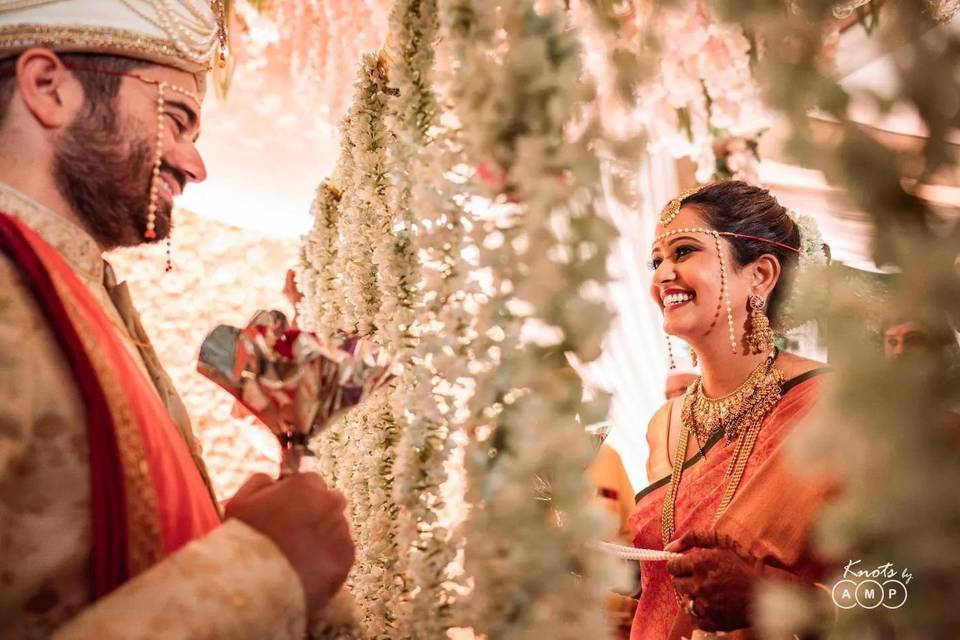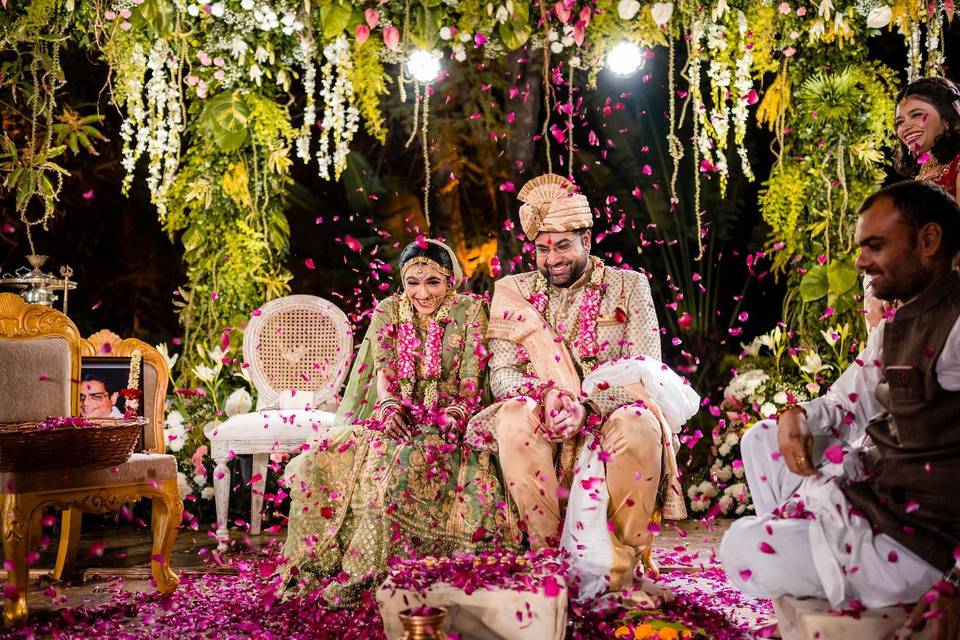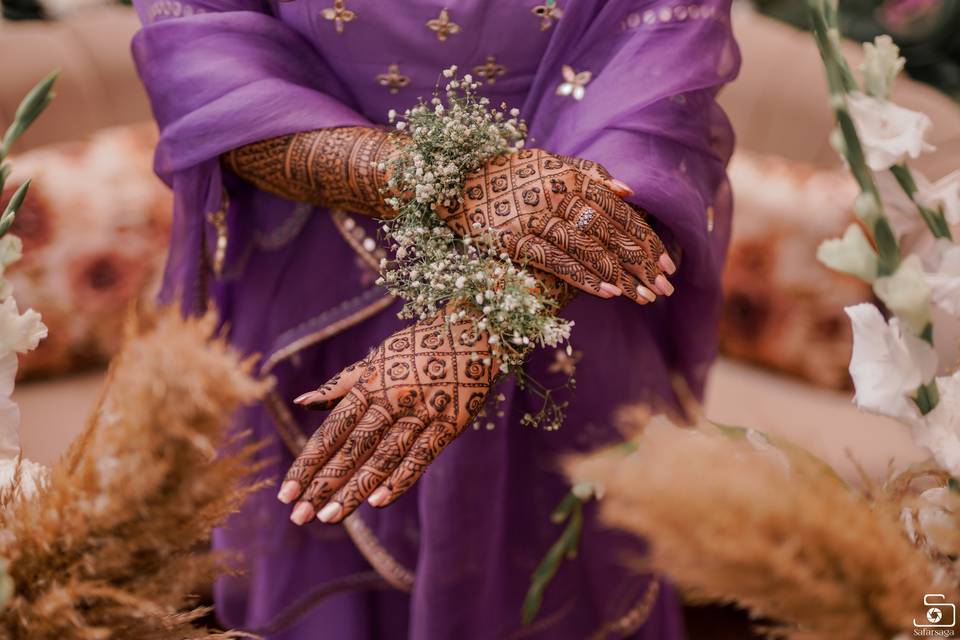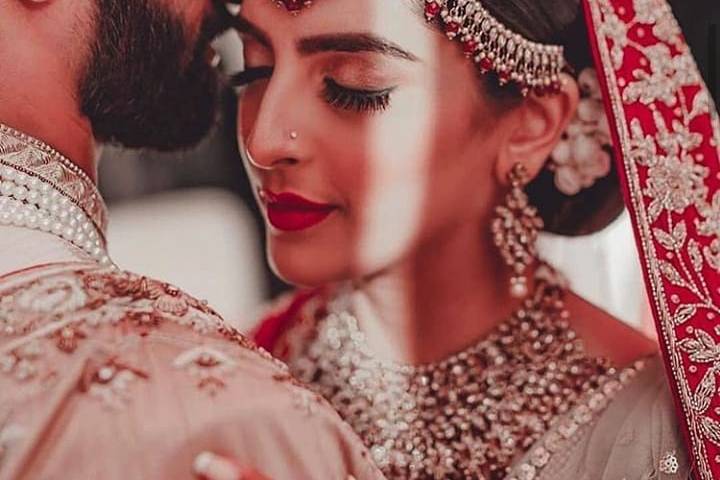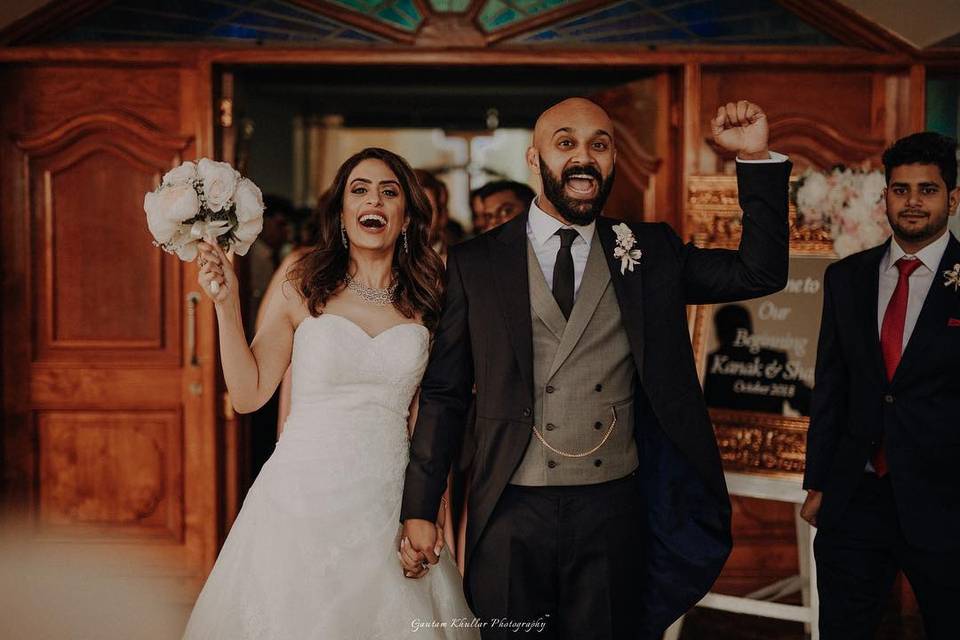Get a Closer Look at the Royal Marwari Wedding Traditions
From Roka, Mahira Dastoor, Tilak to Bidai, Grihapravesh and Jua Khilai- know everything there is about Marwari Wedding Traditions & their royal vibes!
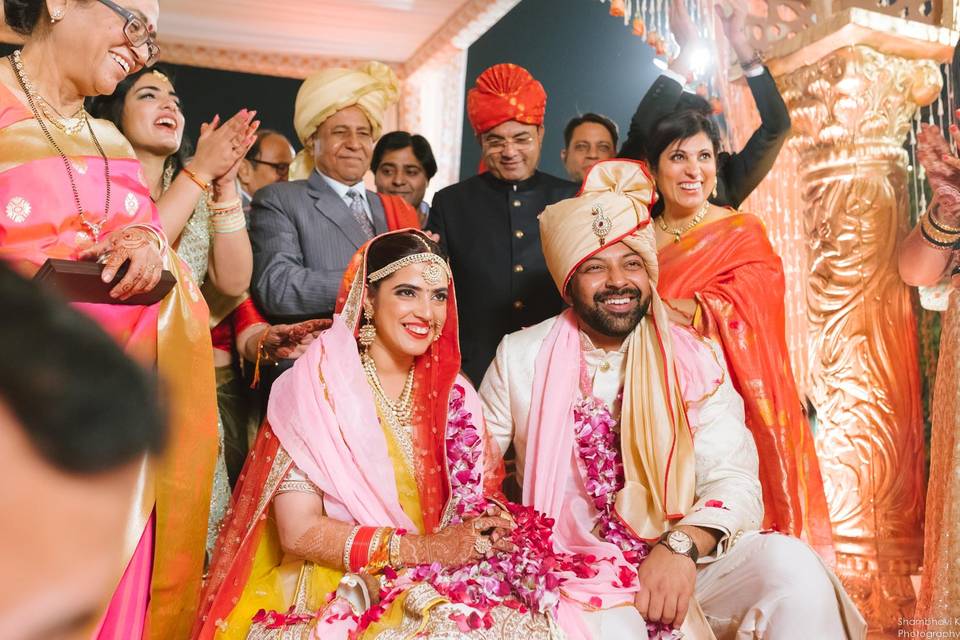
Marwar, the historical land of the Royals, still has rich vibes in its culture and traditions. With their colourful wedding attires, grand music and exotic cuisines, you get the feeling of attending a real majestic wedding. From Byaah Haath to Jua Khilai a Marwari Wedding is a bouquet of traditions accessorised with vivid emotions.
Grand, vibrant, lavish, and glamourous- these are the terms that precisely define a Marwari wedding. Rajasthan is known for its rich culture and colourful traditions. Therefore, it's only natural that their weddings are a pure display of those elements. Typical Marwari weddings have elaborate pre-wedding, wedding and post-wedding rituals that are very interesting and fun.
So, if you're about to get married in a Baniya or Marwari family, it's a good idea to get accustomed a little bit to the Marwari Wedding and its raditions. Read on to get a closer look at the wedding customs and rituals.
How about we take you on an exclusive tour of wedding rituals and traditions- Marwari style so that you can learn all there is to know about Marwari Wedding?
PRE WEDDING RITUALS
Roka Ceremony
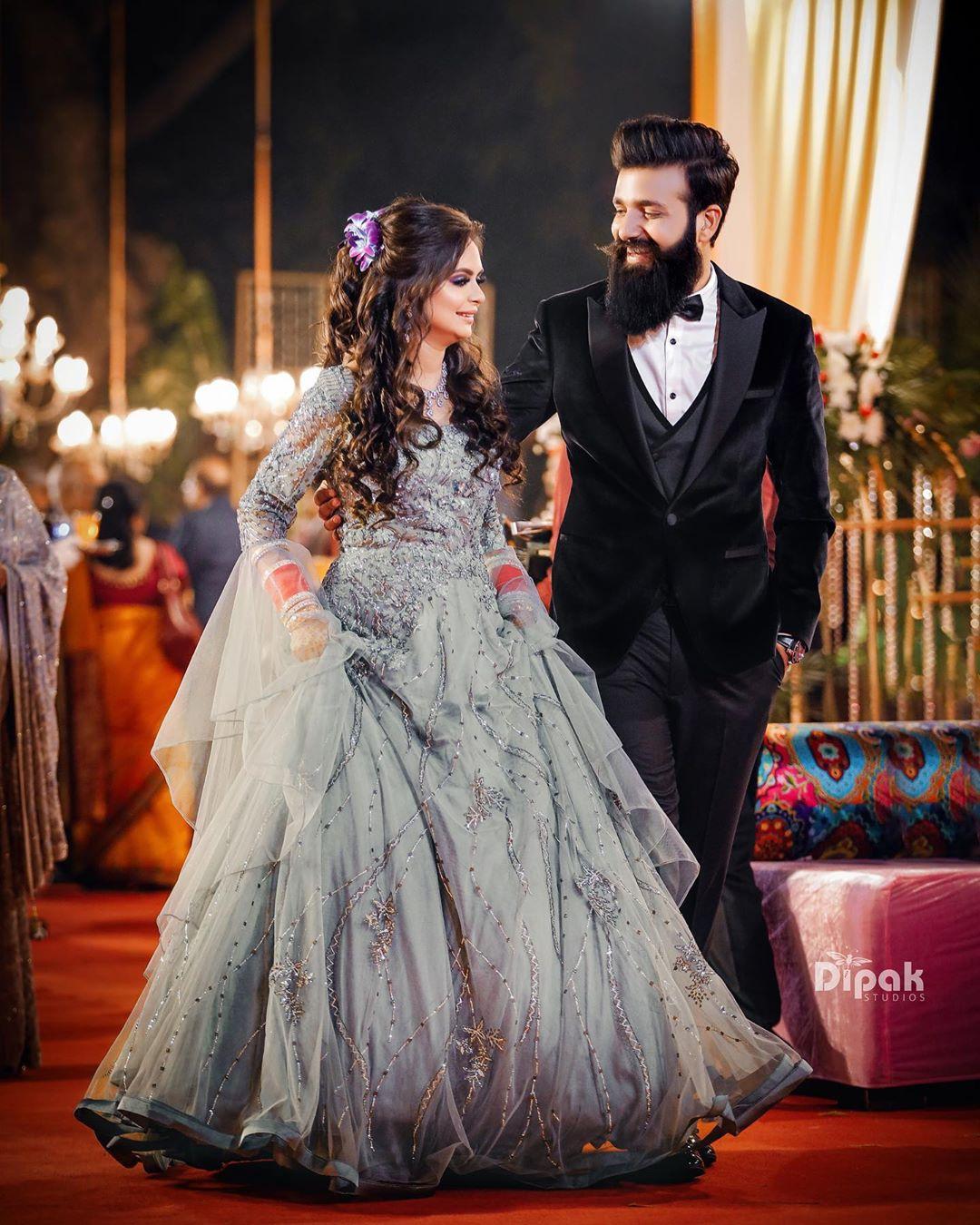
A Roka ceremony is one of the earliest Marwari wedding traditions that happens a few months before the wedding date. A Marwari or Baniya Roka is similar to a Punjabi Roka ceremony when is basically the official union of both the families. Parents from both families perform Tilak as a blessing to the bride and the groom and then they exchange gifts. It's usually a homey affair, but some families also prefer to make a big celebration out of the day.
Byaah Hath & Bhaat Nyotana

Byah Haath usually starts 7 to 10 days prior to the Marwari Wedding. Once the wedding date is finalised, all the women in both families sing Mangal Geet while preparing homemade sweets made of lentils and jaggery called Mangodi. That's Byaah Haath. The mother of the bride/groom then invites everyone in the family (including her siblings' in-laws & their families) or as they call it, performs Bhaat Nyotana. This is an official wedding invitation custom that begins with a Naandi Ganesh Puja to ensure a hassle-free wedding.
Lord Ganesha and other family deities are worshipped at Naandi Ganesh Puja to ensure a hassle-free wedding.
Raatri Jaga & Mudda Tikka
Raatri Jaga is a ritual performed to ward off the evil forces. In this, all holy symbols like the Swastika or Om are hand-painted on the walls and floors. As per Marwari wedding traditions, the groom and his family visit the bride's home for Mudda Tikka or Sagai ceremony. During this occasion, both families exchange gifts and sweets while the couple exchange engagement rings. Sometimes a Roka and a Sagai are merged together to one big function.
Pithhi Dastoor
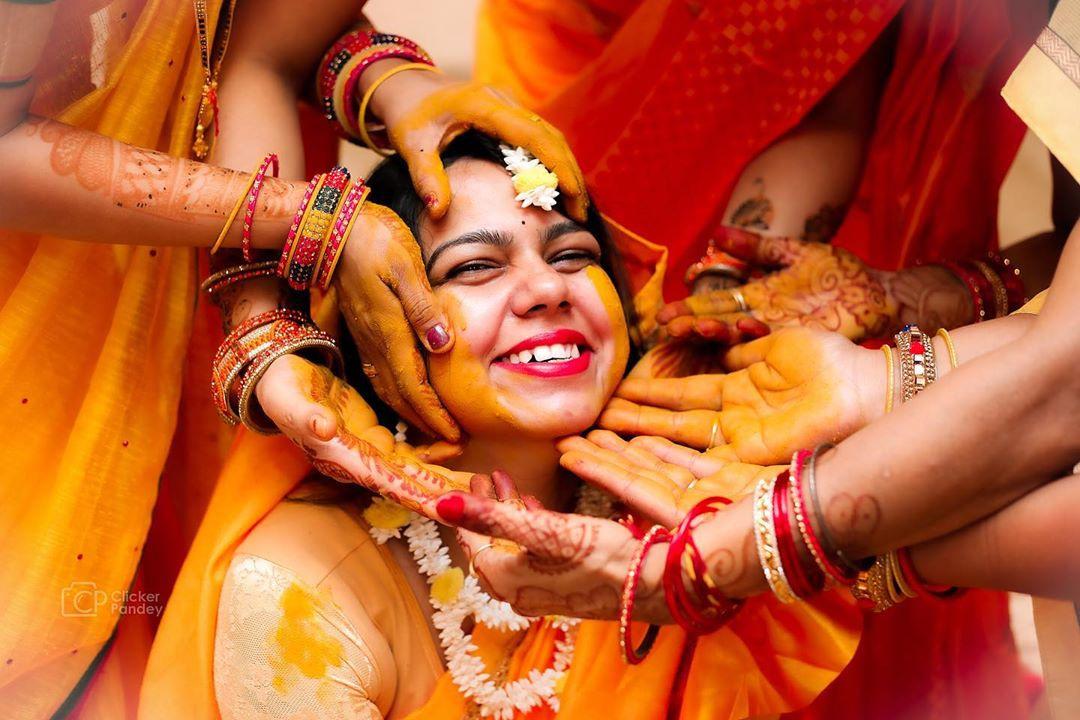
Image Courtesy: Clicker Pandey
Pitthi Dastoor (Haldi ceremony) and Mehndi are celebrated in Marwari weddings more or less in a similar fashion as the rest of the country. A paste of Haldi and sandalwood is applied to the bride/groom and they're not allowed to step out of their homes after that until the wedding.
Telbaan

The bride and the groom are each given a holy bath after applying turmeric paste, mustard oil and curd. Then they are offered to eat special jaggery sweets called Ghungra. After that, the maternal uncle gives the bride/groom Shagun money for good luck.
Mehndi Ceremony

Image Courtesy: Neha Assar
The Mehndi is considered as a Shagun (auspicious token) for the bride. One unique Marwari wedding tradition (especially in Baniya weddings) is that along with the bride, it's mandatory for the groom to apply Mehndi on his hands too. So while you're at it, look for some stunning groom's Mehndi designs too!
Mahira Dastoor

Typically as per Marwari wedding traditions, the role of the maternal uncle (Mama) and aunt (Mami) is very significant. In a Mahira Dastoor, the bride and groom's Mama-Mami bless them with gifts, token money, and clothes. The mother of the bride welcomes the mama by serving him homecooked meals. The basic thought behind this particular custom is that a woman's brother has to take care of her and her family even after she gets married. Hence Mahira Dastoor is celebrated quite grandly in a Marwari or Baniya wedding.
Palla Dastoor

As per the Palla Dastoor, representatives from the groom's family gift the bride and her family with clothes, jewellery, sweets, fruits and the likes wrapped in beautiful trousseau trays. The bride is supposed to wear the same clothes & jewellery at the wedding. This tradition is quite similar to the wedding Tatto gifting tradition in a Bengali wedding.

Image Courtesy: A True Story
Note: Janeu is a ritual where the groom wears a saffron-coloured robe and the priest ties a sacred thread around while performing a Havan.
Mehfil

As per the Marwari wedding traditions, the Mehfil is an all-men Bachelor’s party and an all-women Bachelorette party, happening separately. The groom, his groomsmen and all the other men share jokes, drink, enjoy Rajasthani folk music and dance performances all night long before the D-day.

Image Courtesy: Snapsoul
Similarly, the bride enjoys her last night of singlehood with her gals. The Mehfil has fused into modern versions of bachelor’s and cocktail parties these days with Bollywood music along with traditional songs.
WEDDING DAY RITUALS
Marwari wedding traditions consist of a number of rituals that are fun and colourful. So let's take a look at the wedding traditions:
Thamb Puja

Image Courtesy: Pinterest
A Thamb Puja is a ritual where the groom's family priest performs a Puja at the bride's house directed at the pillars of the house. The symbolic idea behind worshipping the building pillars is to ensure a strong foundation between the two families. This is one of the Marwari wedding traditions which is quite unique.

Image Courtesy: Pinterest
A Havan involves creating a pit to light a sacred fire where the priest performs an elaborate Puja. After the Havan is over, 11 priests are served food and offered Dakshina (token money).
A Gharva is performed at the bride's family where Goddess Parvati is worshipped. The idol is decked up with clothes and jewellery that are offered by the groom's family.
Korath & Ganpati Puja

Image Courtesy: Pinterest
Korath is a Marwari wedding tradition where some of the male members of the bride's family, along with their family priest arrive at the groom's house to invite him and his family to the wedding mandap. The groom's family then offers them food and some token money to the priest.
Korath is followed by a Ganpati Puja that's performed by the groom's family right before he begins his journey towards the venue. This Ganpati Puja is also called the mandap ceremony and is performed to seek the blessings of Lord Ganesha for a hassle-free wedding.
Nikasi & Baraat

Image Courtesy: Pinterest
As per Marwari wedding traditions, in a Nikasi the husband of the groom's sister lovingly decks up the groom by tying a fancy Sehra on his head. Groom's sister then applies a kajal dot on his face and ties a golden thread on the mare to ward off evil. The mare is also decked up with jewellery and the priest performs a Puja. The mother of the groom then feeds him a mixture of lentils, rice, sugar & ghee which is considered as auspicious.

The Baraat or the groom's procession is then ready to head towards the wedding venue. People dance and sing along with the mare accompanying the groom to the mandap.
Toran & Baraat Dhukaav

The wedding venue entrance is decorated beautifully with Toran (decorative arch hanging) that the groom has to touch before entering. Just before his entrance, the groom hits a Neem tree with a stick. This is one of the Marwari wedding traditions that's performed to cast away all negative energies.
The bride's mother then welcomes the groom by feeding him sweets, flowers and performing Aarti.
Jaimala & Granthibandhan

Image Courtesy: Rohit Events RTM
Once the bride is brought to the mandap, she has to put seven Suhalis (kind of snacks) on the groom's hands. This is when the couple exchange floral Jaimalas or Varmalas with each other.

Right after the Jaimala ceremony, Granthibandhan or Ganthbandhan is performed. According to Marwari wedding traditions, one end of the bride's veil or Churni is tied with an end of the groom's waistcloth to make a knot. This cloth is then placed at the groom's shoulder. This whole ritual signifies the union of the couple.
Kanyadaan

Image Courtesy: P. Taufiq Photography
A Kanyadaan ritual as per the Marwari wedding traditions is similar to the Kanyadaan rituals in most Hindu marriages. This is the moment when the father of the bride gives away his daughter to the groom. He first explains their family lineage to the groom and asks him if he can promise to take her responsibility. Similarly, the bride is asked if she's willing to accept the groom's family and his surname. The couple then takes an oath to support and be with each other through thick and thin.
Panigrahan
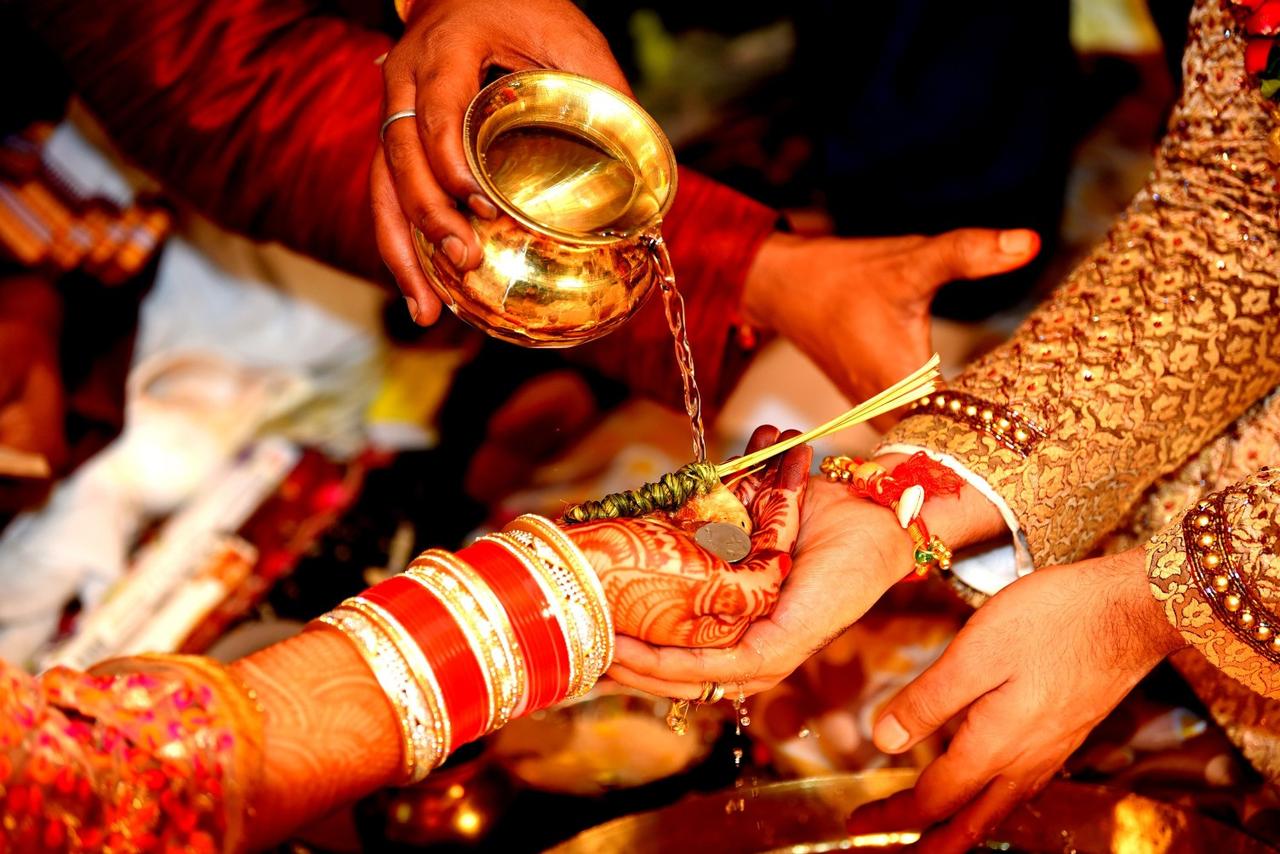
Image Courtesy: Vogue
Pani means hand and Grahan mean acceptance. After the Kanyadaan, the bride's father places his daughter's hand over the groom's hand and asks him to accept her as his wife. This particular Marwari wedding tradition represents the union of two souls.
Saptapadi/Phere & Ashwaroham

Just like other Hindu wedding traditions, the couple takes seven rounds around the holy fire seven times in a Saptapadi or Saat Phere while chanting mantras together. With each round, the bride has to push a grinding stone with her toe which signifies the warding off challenges away from their lives. This ritual is called Ashwaroham. The bride also needs to touch Mehndi paste after each round.
Vamang Sthapana

Image Courtesy: Pinterest
The Vamang Sthapna is when the bride's brother gives her a handful of puffed rice and she has to throw it into the sacred fire together with the groom. This ritual is performed three times and is exactly the same as the Khoi Fela ritual in a Bengali wedding.
Sindoor Daan or Sumangalika

Image Courtesy: Stories By Joseph Radhik
The next step is the Sindoor Daan where the groom applies vermillion on the bride's hair mid parting. The couple then stands facing the North star. During the Sindoor Daan ritual, the mother of the groom gives the bride a Nathni or a Nath which she's expected to wear once the Havan is over.
Aanjhala Bharai

Image Courtesy: Maninder Singh Photography
Aanjhala Bharaai is believed to be one of the most significant Baniya or Marwari wedding traditions. The father of the groom drops a bag of money at the lap of the bride. The bride is then expected to divide the money equally and distributed among her sister-in-law, and her husband. This custom signifies the financial responsibility that a bride is supposed to take care of efficiently.
Paharavani

Once all the Marwari wedding traditions are over, as per a Paharavani, the groom has to sit on a new cloth and the bride’s family showers him with gifts. Both the families and the priests bless the new couple for a prosperous future. The bride pays respect to her father's home and performs a Puja at the threshold. Finally, she breaks an earthen lamp with her feet at the exit.
Joota Chupai

Joota Chupai is one of the most fun Marwari wedding traditions that is performed North Indian weddings and now almost every wedding in India. Once the wedding is over and the groom is about to exit, his shoes are being stolen by the bride's sisters and brothers. An amount of token money is demanded in exchange for the shoes. This eventually becomes quite a fun negotiating wedding game among the team bride and team groom!
Sir Guthhi & Sajjan Goth

After a long tiring day of the wedding, an elderly lady of the house combs bride's hair washes her face to freshen her up. That's a Sir Guthhi.
An elaborate Marwari traditional meal is arranged by the bride's family. This meal is personally served by the bride's father and other male members of the family. Dal Baati Choorma, Ker Sangri, Gatta curry, Lal Maans, Gatta Pulav are some of the must-add Rajasthain delicacies in the menu.
POST WEDDING RITUALS
Jua Khilai & Bidaai

Jua Khilai takes place the next morning at the bride's house. It involves a lot of fun wedding games that usually the Mami of the bride arranges. During these games, everyone cheers the couple. The games are designed in a fashion that it tests the compatibility between the newly-wed couple.
Before the Bidaai ceremony, the couple is taken to the kitchen and a Thali Puja is performed. A half-dried coconut filled with coins and sugar is handed to the bride which she later gives to her mother-in-law.
Everyone bids the bride farewell with teary eyes. A coconut is broken by the car wheels which is considered as a good omen.
Grihapravesh/Bahu Agaman

Image Courtesy: Pinterest
The bride is welcomed to her new family as per Marwari wedding traditions. First, her sisters-in-law guard the entrance in jest and ask for some gifts and bribe in order to let the couple in. The groom's aunt then performs Aarti and welcomes her home. The bride has to topple down a jar full of rice with her foot, dip her feet into a red dye and walk inside the house leaving red footprints.
The bride is then asked to touch ghee and jaggery and then a bag full of money signifying prosperity and harmony in the family. The couple is then asked to light a lamp in their house temple and offered sweets.
Pagelagni & Chura

Finally, an elderly lady takes off the bride's veil and that's when everyone blesses the couple. The bride is formally introduced to all the family members and she touches their feet for blessings, which is known as Pagelagni.
The groom's mother then adorns the bride's hands with beautiful lac Choodas as a symbol of marital Shringar.
Pag Phera

After a day or two, the bride visits her paternal home along with the groom and the newly-wed couple is heartily welcomed. The young siblings and cousins tease the groom and crack light-hearted jokes about their first night! They all enjoy a hearty meal together spend some quality time and the couple then returns to the groom's home in the evening with loads of gifts from the bride's family.
THE WEDDING OUTFIT
The Marwari Groom
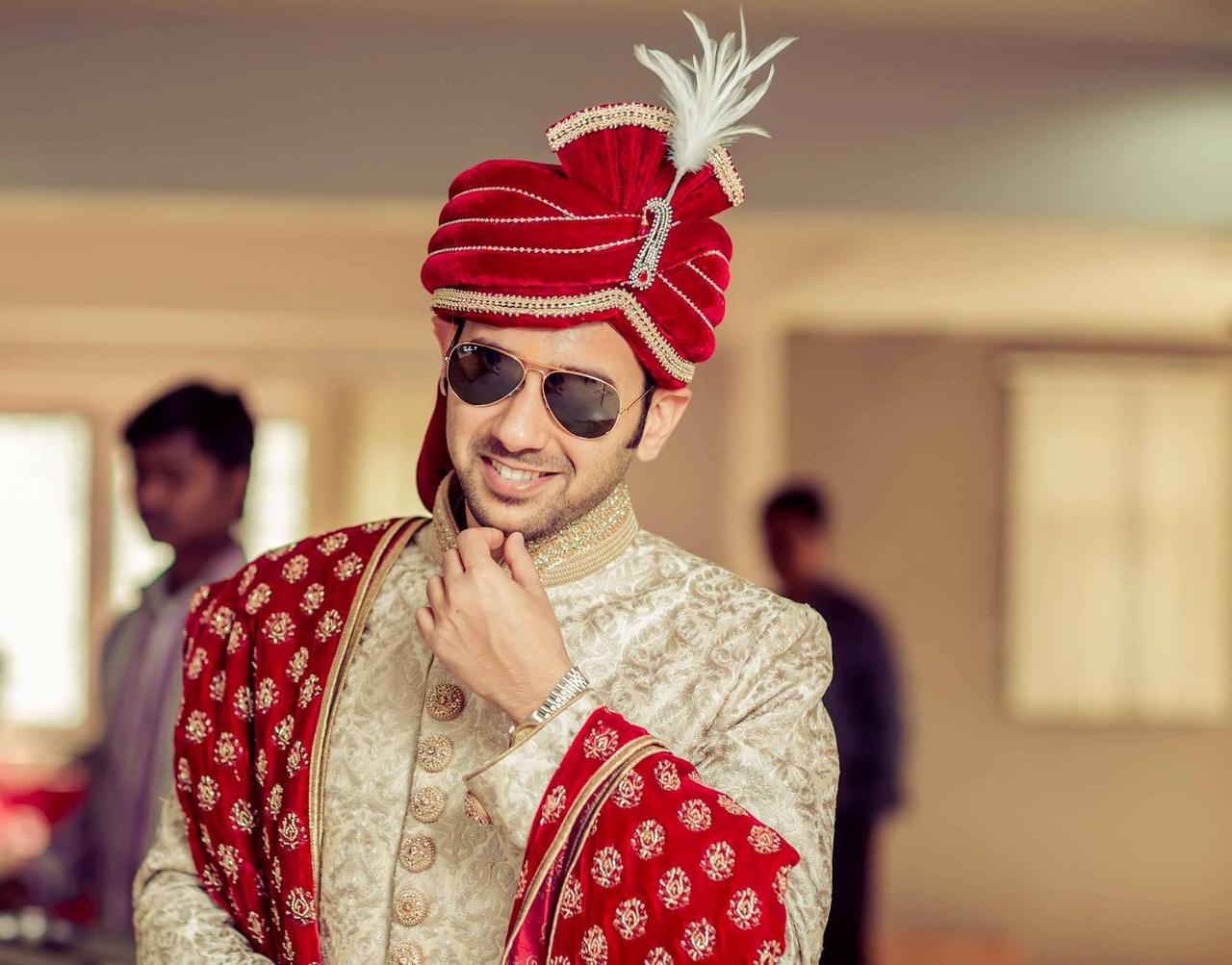
Image Courtesy: Lifestory Films
A Marwari groom sports either an Achkan over a Jodhpuri or a sherwani paired with a Churidar pyjama. A red Bandhni printed turban held together by traditional jewellery called Sarpech enhances the royal look. And just like a Rajput, a Marwari groom dons gold or a pearl necklace or a Jadau piece and wears a Kamarbandh with a Sword tucked in.
The Marwari Bride

Image Courtesy: Praveen Bhatt Photography
The traditional Marwari bride wears heavily embroidered bridal lehenga with stone and crystal embellishments. The lehenga is paired with an equally heavy Odhni covering the bride’s face. Fort the pheras however, she may don a Pavri ki saree, which is a gift from her in-laws. If it is combined with the lehenga then she may choose to drape it like a dupatta over her existing bridal attire.
Rakhri, Borla (Maang tikka), Timaniyaan (diamond-studded choker), Choodiare (bangles), Bajuband (armlet), Bichhiya (toe-ring) and Nath (nose ring) are some of the mandatory Marwari jewellery to be adorned by a bride. Most jewellery is made of gold with elaborate Jadau, Meenakari and Kundan work-a speciality of Marwar region.
Now you know how gorgeous and glamorous a Marwari wedding is. If you’re planning a Marwari wedding for yourself, or for your friend, consult with the Wedding Planner to add an authentic regional aura to the wedding. Hire Mehndi artists or folk musicians from Rajasthan to have a spectacular Mehfil. And don’t forget for a taste session of that special Laal maas before finalising the caterer.
Did you find the wedding traditions interesting? Share your thoughts and experiences with us in the comment section below.




